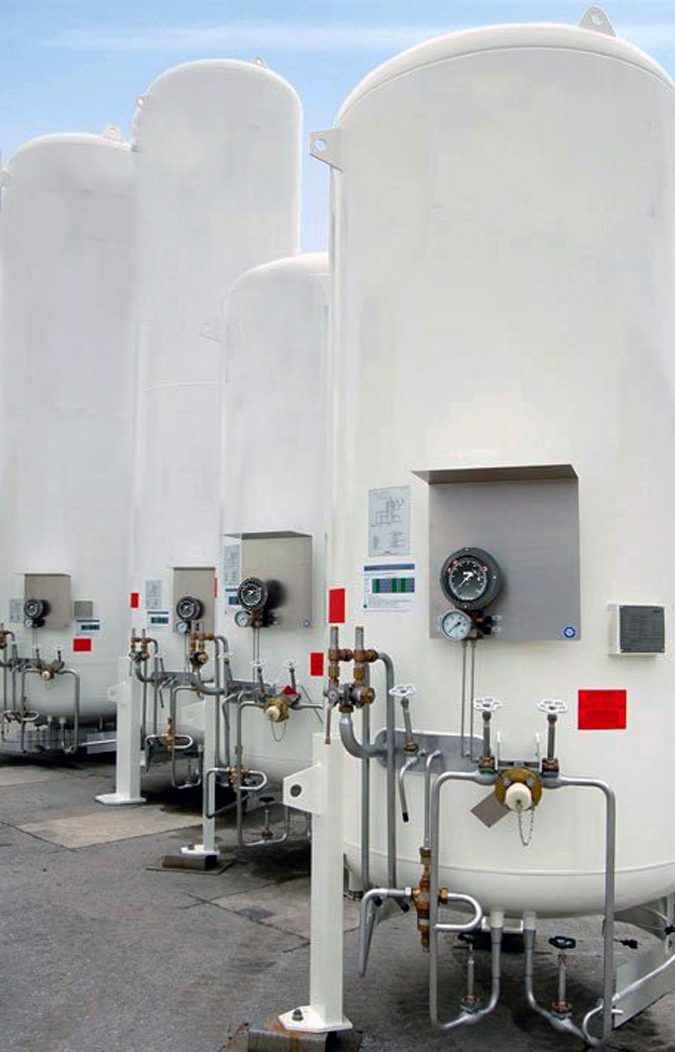
Mid-West Instrument has considerable experience with cryogenic liquids, which exist at extremely low temperatures and require specialized equipment for transportation and storage. If you tried storing cryogenic liquids in a standard container, the liquids would not only be impossible to handle, but they would also present health and safety risks to the handlers. Thus, cryogenic tank design, use, and safety in the Midwest are of the utmost importance.
What is a Cryogenic Tank?
A Cryogenic tank (or ‘cryotank’) is a container used to store cryogenic liquids such as liquid nitrogen, helium, or argon. These tanks need to be thermally insulated to maintain exceptionally low temperatures, and this is achieved through the use of a vacuum jacket. This jacket is designed and manufactured to a high specification that meets established international design codes.
The most common type of cryotank are ‘static’ or ‘fixed’ tanks that are used in a fixed location, i.e. a cryogenic processing facility. One especially popular type of static cryotank is pressure vessels, which are mounted on wheels and used in labs and workshops. Also in this category are non-pressurized open-neck vessels called Dewar flasks, which come in handy in scenarios where direct access to cryogenic liquid is required.
Where do Cryotanks Fit in the Cryogenic Treatment Process?
Cryogenic tanks are integral to the entire cryogenic treatment process. Without these tanks, transportation and storage of cryogenic liquids would be impossible. Moreover, the efficacy of cryotanks isn’t just limited to the storage and transport of the cryogenic materials – these tanks also play an important role in the deep cryogenic treatment process, where metals and plastics are submerged in cryogenic liquids for up to 24 hours. As mentioned earlier, it’s simply not feasible to do this with a conventional tank. Too many factors are at play that would disrupt the treatment process.
Cryotanks – Regulations
Not surprisingly, there’s a substantial amount of legislation and regulations governing the industrial use of cryotanks, and every registered cryotank must be operated and maintained in a manner that complies with these regulations. For example, only designated, highly trained personnel are to maintain and manage a company’s cryotanks. Also, cryotanks in the Midwest are subject to vigorous inspections by certified inspection bodies at regular intervals, as well as routine maintenance and periodic formal examination. The results of these examinations are meticulously documented and the records are retained for the life of the tank. These specific maintenance and inspection rules were created to ensure that each cryotank will consistently allow for safe operation during the periods between formal examinations.
Learn More About Cryotanks Today
Companies in the Midwest that own/use cryogenic tanks must abide by a strict set of rules governing care and safety. Also, responsible gas suppliers will only fill a cryogenic tank when they’re 100% satisfied that it’s safe to do so.
Measuring liquid level in the cryotank and alerting when it is time to contact a supplier for refilling is vital to the smooth operation of organdizations like hospitals that rely on cryogenic gasses. To learn more about measuring the liquid level inside cryotanks, contact Mid-West Instrument.
Mid-West Instrument
Since 1958, Mid-West Instrument has been a leading global manufacturer of differential pressure gauges, transmitters, and switches. Our company is family owned and operated from our facility located in Sterling Heights, MI.

